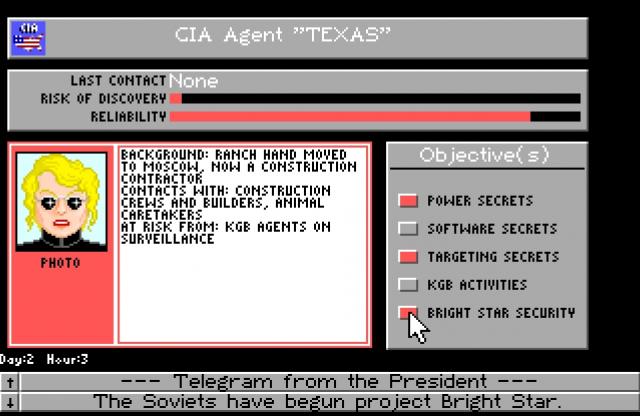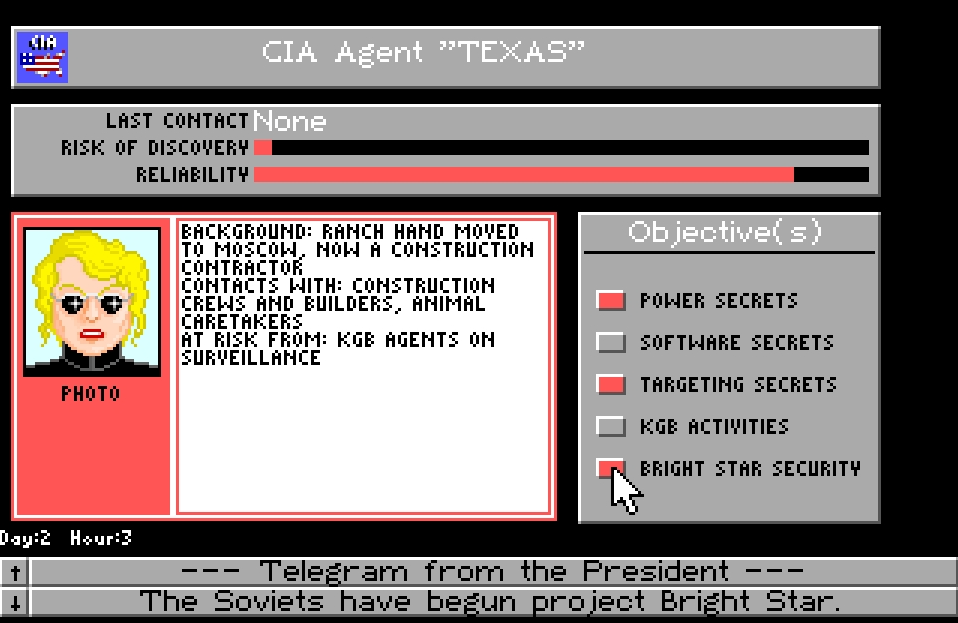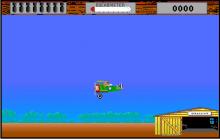Tom Clancy's The Cardinal of the Kremlin
How to play Tom Clancy's The Cardinal of the Kremlin
- Plan Missions: Use the top-down map to select targets and plan your espionage missions.
- Gather Intelligence: Deploy spies to gather crucial information and weaken enemy operations.
- Manage Resources: Allocate resources wisely to ensure the success of your missions.
- Execute Operations: Carry out your plans while adapting to changing circumstances and enemy actions.
- Analyze Outcomes: Review mission outcomes and adjust your strategies for future operations.
Tom Clancy's The Cardinal of the Kremlin Description
Tom Clancy's The Cardinal of the Kremlin is a captivating turn-based strategy game set in the throes of Cold War espionage. Released in 1990 for DOS, this game immerses players in a tense world of political intrigue and high-stakes strategy. Based on the thrilling novel by Tom Clancy, players are tasked with navigating the complex web of espionage between the United States and the Soviet Union.
In Tom Clancy's The Cardinal of the Kremlin, players take on the role of CIA operatives working to undermine Soviet intelligence operations while simultaneously managing their own spy network. The game’s top-down perspective offers a strategic overview of the battlefield, allowing players to plan and execute their missions with precision. Players must gather intelligence, conduct surveillance, and make crucial decisions that will determine the fate of the Cold War.
The game's immersive atmosphere is further enhanced by its detailed graphics and authentic Cold War settings. As players delve deeper into the game, they will uncover secrets and face challenging scenarios that test their strategic thinking and adaptability.
Cheats/Hints/Walkthroughs for Tom Clancy's The Cardinal of the Kremlin

Tom Clancy's The Cardinal of the Kremlin - additional information

Tom Clancy's The Cardinal of the Kremlin: A Classic 1990 DOS Game
Tom Clancy's The Cardinal of the Kremlin is a gripping DOS game released in 1990 that immerses players in the intricate world of Cold War espionage. Based on Tom Clancy's novel of the same name, the game masterfully blends strategy and adventure, offering a unique experience for fans of the genre. This article delves into the details of The Cardinal of the Kremlin, exploring its gameplay, historical context, and lasting impact on the gaming world.
Gameplay and Features of Tom Clancy's The Cardinal of the Kremlin
Strategic Espionage and Tactical Decisions
Tom Clancy's The Cardinal of the Kremlin puts players in the role of CIA operatives working to thwart Soviet advances in the Cold War. The game emphasizes strategic planning and tactical decision-making, requiring players to gather intelligence, manage resources, and execute covert operations. Each mission demands careful thought and precision, reflecting the high stakes of Cold War espionage.
Immersive Storyline and Characters
Staying true to Tom Clancy's reputation for intricate storytelling, The Cardinal of the Kremlin features a compelling narrative that draws players into the world of international intrigue. The game introduces players to a cast of characters, including spies, diplomats, and military personnel, each with their own motivations and secrets. The depth of the storyline adds layers of complexity, making each mission not just a challenge but a crucial part of the overarching plot.
Detailed Graphics and Sound Design
For a game released in 1990, The Cardinal of the Kremlin boasts impressive graphics and sound design. The detailed environments and character sprites enhance the immersive experience, while the atmospheric soundtrack and sound effects heighten the tension during critical moments. These elements combine to create a believable and engaging world that captivates players from start to finish.
Historical Context and Cultural Impact
Reflection of Cold War Tensions
Tom Clancy's The Cardinal of the Kremlin is set against the backdrop of the Cold War, a period of geopolitical tension between the United States and the Soviet Union. The game's missions and storyline are heavily influenced by real-world events and espionage tactics used during this era. This authenticity provides players with a deeper understanding of the complexities and dangers of the Cold War, making the game both educational and thrilling.
Influence on the Strategy Game Genre
The Cardinal of the Kremlin is considered a pioneering title in the strategy game genre. Its emphasis on espionage and tactical decision-making set it apart from other games of its time, influencing subsequent titles in the genre. The game's success demonstrated the potential for video games to tackle complex political and historical themes, paving the way for future strategy and simulation games.
Enduring Legacy
Despite being over three decades old, The Cardinal of the Kremlin remains a beloved classic among retro gaming enthusiasts. Its unique blend of strategy, storytelling, and historical context continues to captivate players, earning it a place in the pantheon of great DOS games. The game's enduring popularity is a testament to its quality and the lasting appeal of Tom Clancy's storytelling.
Similar Games to Tom Clancy's The Cardinal of the Kremlin
For fans of The Cardinal of the Kremlin, several other classic DOS games offer similar experiences in terms of strategy, espionage, and historical themes. Here are a few recommendations:
Sid Meier's Covert Action
Released in 1990, Sid Meier's Covert Action is another espionage-themed strategy game that puts players in the shoes of a CIA agent. The game combines tactical missions with a broader strategic framework, requiring players to gather intelligence, decipher codes, and thwart international threats. Its blend of action and strategy makes it a must-play for fans of The Cardinal of the Kremlin.
Red Storm Rising
Also based on a Tom Clancy novel, Red Storm Rising is a submarine simulation game released in 1988. Players command a submarine during a hypothetical World War III scenario, engaging in naval warfare and stealth missions. The game's attention to detail and strategic depth make it a compelling choice for those interested in Cold War-themed games.
Twilight: 2000
Twilight: 2000, released in 1991, is a role-playing game set in a post-apocalyptic world following a hypothetical World War III. Players lead a group of survivors through a war-torn landscape, making strategic decisions to ensure their survival. The game's focus on tactical gameplay and its Cold War backdrop make it a fascinating counterpart to The Cardinal of the Kremlin.
Tom Clancy's The Cardinal of the Kremlin is a standout title in the history of DOS gaming, offering an unparalleled blend of strategy, storytelling, and historical authenticity. Its depiction of Cold War espionage, combined with its engaging gameplay and immersive graphics, ensures its place as a timeless classic. Whether you're a veteran gamer or new to retro gaming, The Cardinal of the Kremlin is a must-play experience that showcases the best of what the genre has to offer. For those who enjoy this game, exploring similar titles like Sid Meier's Covert Action, Red Storm Rising, and Twilight: 2000 can provide even more thrilling adventures in the world of strategy and espionage.
















Write a comment